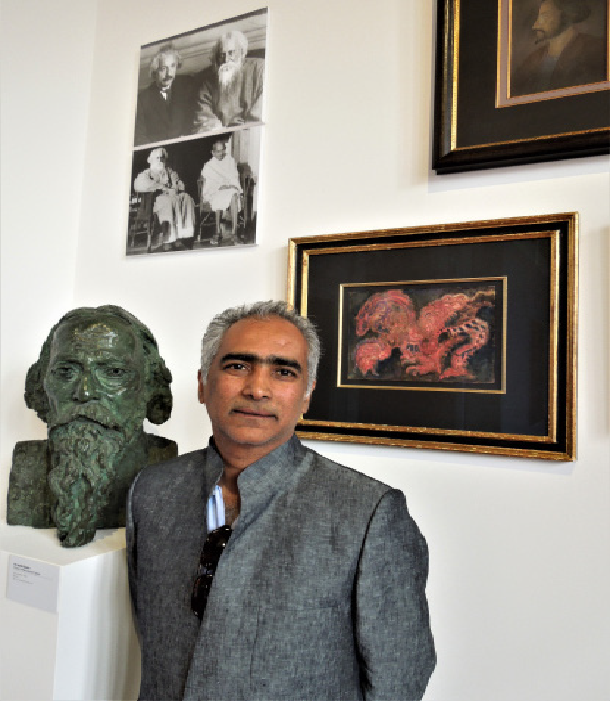
By: LakshmiPS
EXHIBITION WAS FIRST MAJOR TRANSCULTURAL EVENT IN MODERNISM, SAYS ART HISTORIAN
by AMIT ROY
Sundaram Tagore, one of the most important Indian gallery owners in the world, is to make a film about an exhibition held by artists from Germany’s Bauhaus movement in Calcutta (now Kolkata) in 1922.
This might at first seem a little esoteric except that the Bauhaus, which is celebrating its centenary this year, represented the most avant-garde group of artists of their time.
According to the noted art historian Prof Partha Mitter, whom Sundaram wants to interview for his story, “Bauhaus was arguably the most important movement that shaped global modernism”.
Sundaram, who owns galleries in New York, Hong Kong and Singapore, travels the world seeking out the best of “east meets west” contemporary art.
He has just completed a documentary, Tiger City, on the American architect Louis Kahn, who designed, among other projects, the Indian Institute of Management in Ahmedabad and the Jatiyo Sangshad Bhaban (National Assembly Building) in Dhaka, Bangladesh.
The 1922 exhibition of some 250 works of art was held “in Samabaya Bhavan behind the Park Hotel in Calcutta,” said Sundaram.
Among the artists whose works were shown – Wassily Kandinsky, Paul Klee and Johannes Itten – were some who had become celebrities in Europe.
“I am interested in the confluence of cultures and this exhibition happened because Rabindranath Tagore was there,” explained Sundaram.
At Waterstones’ main branch in London’s Piccadilly, there is currently a display of several books on Bauhaus to mark its centenary. The Staatliches Bauhaus, commonly known as the Bauhaus, was a German art school operational from 1919 to 1933.
The Bauhaus, founded by Walter Gropius in Weimar, had a profound influence upon subsequent developments in art, architecture, typography and graphic, interior and industrial design. The school was closed down under pressure from the Nazi regime, which saw it as a centre of communist intellectualism.
Why Europe’s leading avant-garde artists should have wanted to show their work in Calcutta has intrigued Sundaram: “Calcutta couldn’t do that now.”
Prof Mitter told Eastern Eye: “Why Calcutta? Without a doubt, Rabindranath Tagore’s global reputation had a lot to do with it. For instance, his birthday was celebrated in May 1921 at the National Theatre in Weimar.”
He described the exhibition as “the first major transcultural event in the history of modernism”.
Mitter, who has been consulted by the Germans because of his scholarship, said: “In 2009, I was invited by the Bauhaus Foundation in Berlin because of my work on the Bauhaus in Calcutta published in my book, The Triumph of Modernism: India’s Artists and the Avant-garde 1922-1947.
“I was also involved with the exhibition, Das Bauhaus in Kalkutta, held in Dessau in Germany in 2013. This is the centenary year of the Bauhaus, and I have contributed essays in exhibition catalogues comparing the teaching methods of the Bauhaus and (Tagore’s university) Santiniketan.”
In a paper presented at a conference called Bauhaus Global, Mitter said: “There is no question of the importance of this avant-garde architecture in the rise of modernism. Its discourse has become part of our everyday language.”
He said that the exhibition held in Calcutta “literally brought the European avant-garde to its doorstep, which had hitherto been nourished on the staple diet of Victorian academic art.
“How was it possible that Calcutta, a distant Asian city, so far from the centre of modernism, could be a site for showcasing these leading artists of European modernism, and why were they keen to show their works here?
“Far from being a totally surprising event that had the function of educating a passive audience, the exhibition was received by a conscious Bengali public with a critical appreciation.
“The ground had already been prepared by lively interactions between Indian and German intellectuals in the previous decades.”
Referring to Tagore, he added: “The great Indian poet and the first non-European Nobel laureate was arguably the most famous international figure in the inter-bellum years 1919-1939. His reputation was perhaps nowhere higher than in Germany and Austria, his works inspiring intellectuals and creative individuals in a wide range of fields.
“The Germans felt special affinities with Indian resistance to British colonial rule because of their own defeat in the war of 1914-18.
“For the Indian intelligentsia, it was particularly refreshing to communicate with a nation that was not primarily associated with British colonial rule.”
Mitter confirmed: “Tagore was responsible for inviting the artists of the Bauhaus to exhibit in Calcutta in 1922. His personal reputation carried weight among the artists…. Tagore, who knew the Indian movement, could see similarities in their rejection of naturalism with ideas of the Bauhaus modernists.”
Mitter went on: “The cultural links developing between Germany and India were reinforced with the Bauhaus show, and continued into the 1920s and 1930s.”
